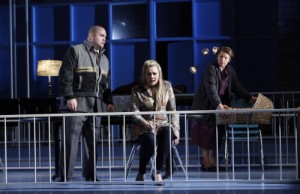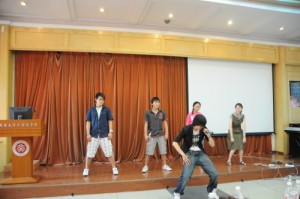by Janice L. Mayer
The Makropulos Case conjures up tales of phenomenal designer shoes as well as miraculous longevity in its heroine. In my last blog, Cheryl Barker spoke of stunning heels that helped her achieve a stately presence on stage. Stephanie Sundine, soprano turned in-demand opera stage director, recalls a more down-to-earth moment in this astounding opera by Janáček. “When I sang Emilia Marty in The Makropulos Case at Canadian Opera, I had several quick changes during the run of the show. In one of them, I had to change from gold slippers to black shoes. During one of the performances, the quick change went a little too fast, and I unknowingly ended up with one gold slipper and one black shoe. As soon as I came back onstage, I was blocked to throw myself down on a chaise and put my feet up, with great flair, as only Emilia Marty can do! As I did that, I looked at my feet and realized what had happened. As soon as possible, I put my feet back on the floor and did everything I could to keep them covered with my long black dress. Apparently, I wasn’t entirely successful, because the costumer Suzanne Mess (of whom I had heard for years, but never met) came to my dressing room after the show to playfully scold me for wearing mismatched shoes! That would have to happen on the night an important costumer was in the audience.”
Stephanie’s was a harmless mishap, but this week in the news—both the national news and cultural reporting—pictured leading ladies in a cast. Front page coverage in The New York Times explained that the walking cast on Judge Sonia Sotomayor’s ankle was the result of a tumble while sprinting through New York’s Laguardia Airport earlier this summer. Ironically the judge, who is engaged in Senate confirmation hearings as the first female Latino nominee to the U.S. Supreme Court, is being challenged by the Republican member of the Judiciary Committee as being too empathetic. Watching her hobble into the hearing room and taking the ‘hot seat’ surely brings out my sympathy! Then the Royal Opera’s Il barbieri of Siviglia which featured a notable ensemble was spotlighted. Joyce DiDonato, their effervescent Rosina, bubbled-over and ended up in a plaster cast caused by a spill on stage during Act 1. Ever the trouper, she completed the opera on crutches. The popular mezzo-soprano is expected to finish the ‘run’ of performances in a cast and on crutches, but the shows will go on!
Marjorie Mussman, former soloist with the José Limón and Joffrey Dance Companies, said that she empathizes with singers dealing with raked and uneven surfaces. Marjorie explained that “ballet dancers have to deal with a rake even on flat surfaces because it’s built into their toe shoes; the heel is already a little lower than the balls of the feet in pointe shoes.” She recalled her most challenging moment was on a State Department tour of Central and South America with the highly regarded First Chamber Dance Company of New York. She had a solo in Sir Anton Dolin’s work Pas de Quartre “which featured a sequence of jumps traveling upstage. The movement was challenging in and of itself, and then to perform it in Mexico City where the altitude is over a mile-high was extremely tiring!”
And then there is the adjustment of footwear—or lack thereof—from her time with the Limòn company which customarily dances barefoot to the Joffrey which dances in pointe shoes. Toe shoes lift your arch and I had to get used that again. Also my feet shrank in size and my shoes were actually falling down be cause I had gone down a half size. To keep them in place I started using good old Elmer’s© glue to affix my shoes to my heels during performances!” Today Marjorie teaches the professional advanced class at choreographer Mark Morris’s Dance Center in Brooklyn completing a cycle which began in a Seattle workshop when she taught a 13-year old Mark Morris. “Mark has always been bright and interesting—and fun! People have always gravitated to him, like a pied piper. And he knows music like crazy! He has created a wonderful atmosphere at his dance center; it’s spotless, the floors are all sprung, and we all feel so supported without suffering interference in how we teach from the administration—I can really teach how I teach. They’ve been great to me.” It sounds like the Mark Morris Dance Group has it all in-balance, in Brooklyn!
Speaking of on point, dancer, choreographer and stage director Nicola Bowie shared her experience as beginning dancer with me. “I wanted to be a Classical Ballet Dancer from the age of four,” she said. And for those of us who are privileged to know Nicky as a very gregarious, outgoing adult transplant from the U.K., it may be hard to believe why she started lessons. “I began ballet classes at this early age as my mother felt that I suffered badly from shyness and needed more contact with children of my own age. From the first class I attended I was totally hooked, possessed, obsessed and it was absolutely clear that the world of dance was to be my destiny. I took as many classes as my mother could drive me to and afford to pay for, passed all the relevant exams with honors and at the age of eleven, attended The Legat School of Russian Ballet (a vocational boarding school where academic studies took somewhat of a backseat and you danced from morning until night…bliss). At the age of sixteen I went on to The Royal Ballet Upper School in London. The premises were shared with the Royal Ballet Company. We saw Rudolf Nureyev, Sir Anthony Dowell, Dame Antoinette Sibley and Dame Margot Fonteyn in the canteen on a daily basis (not that anyone was consuming anything other than black coffee, cottage cheese and, of course, the obligatory cigarette).”
And as I’m beginning to believe, every ballerina remembers her first toe shoes and has her own way of customizing them. “Being ahead of the game in terms of my age and stage, I received my first pair of pointe shoes at nine. They were a beautiful pink satin with matching ribbons which my mother painstakingly sewed on. She also darned the toe of the block in order to make them last longer. I have to confess that they never felt completely comfortable to me. (Some of my colleagues later said that it was like putting on a pair of comfortable slippers, alas, not for me I am afraid.) Part of the problem was if you naturally developed hard skin on your feet, you were much better protected. Unfortunately, I was not blessed in that regard. In those days there was a recommend insert of “animal wool” into the toe cap. (One was never sure which animal it came from, and at that time I was so obsessed with putting the shoes on and getting on with the business of dancing, I didn’t care.) The animal wool was supposed to relieve some of the pressure but sometimes it would get hard and lumpy and become counter-productive. With such soft skin I was at high risk of blisters and corn plasters were a frequent purchase from the pharmacy. We were advised to dab our toes with surgical alcohol every night in order to encourage the toughening of the skin but I don’t honestly think that it ever did much for me.
In 1974 my dream came true and I was accepted into the London Festival Ballet (now English National Ballet) a full time classical ballet company presenting the classics such as Swan Lake, Sleeping Beauty, Giselle, Coppelia, Cinderella, and Romeo and Juliet. We would do three major seasons in London and toured both regionally and internationally for the rest of the year. As far as I can remember, I had once week’s rehearsal in London prior to going out on my first tour. In that week I had to learn the corps de ballet roles in Cinderella, Swan Lake and Les Sylphides! This was utterly terrifying and meant many, many hours ‘en pointe’… I somehow kept going and had to soak my feet in Epsom salts each night when I got home. I can still remember the joy at the end of the first week when I received my first pay check of 19 pounds 50 pence (about $30US!). I couldn’t actually believe that I was earning money for something that I loved so much and had been doing for so long.”
Then she headed out on the road and the story takes a turn. “Our first tour date was in Eastbourne, a seaside town on the Sussex coast about 80 miles from London. Unfortunately, I managed to contract the worst cold that I can remember the weekend before we were due to leave. I took everything that I could possibly buy from the pharmacy but it was proceding down to my chest with alarming speed… not a great condition to be in when anticipating extensive cardio activity. Swan Lake has the most dancing within the classical ballet repertoire for a corps de ballet member. There are usually 32 swans and you are onstage throughout Acts II and IV (“the white acts”) with some appearances playing other characters in Acts I and III. There were eight performances scheduled for the first week with matinee and evening performances on Wednesdays and Saturdays. There was considerably more concentrated dancing than I had experienced before, and as you can imagine there was terrific pressure to ‘achieve,’ and to impress the Artistic Director, Dame Beryl Grey. By the time I hit the evening performance on Wednesday my cold was so bad that I was having to inhale steam in the dressing room between acts and stick Kleenex© up my nose in order not to ‘drip’ on the floor during the long stands (not a pretty sight)!” One can only imagine that the rest of the flock were trying to keep their distance and health, an ironic twist since her mother started her in dance to make friends as you recall!
At least her bronchitis distracted her from her feet, she said as she continued her memorable shoe story. “Whilst all this was going on I was trying not to think about my poor feet which were in total shock. Suffice to say that when I came off stage that night wheezing like a warthog, pulling the Kleenex © from my nose, I looked down at my feet to see that a great amount of blood from my toes had seeped through my pointe shoes and thus gave a whole new meaning to ‘The Red Shoes’! I can’t honestly remember how I managed to get through that first week performing as a professional ballet dancer but I guess it happened with a lot of prayer and possibly just a few misgivings as to whether I had ultimately made the best career choice!” Well we’re glad that she made the choice because she has enriched productions with her movement knowledge from coast-to-coast in America—literally from Glimmerglass Opera to Los Angeles Opera—and has encouraged countless emerging performers along the way.

